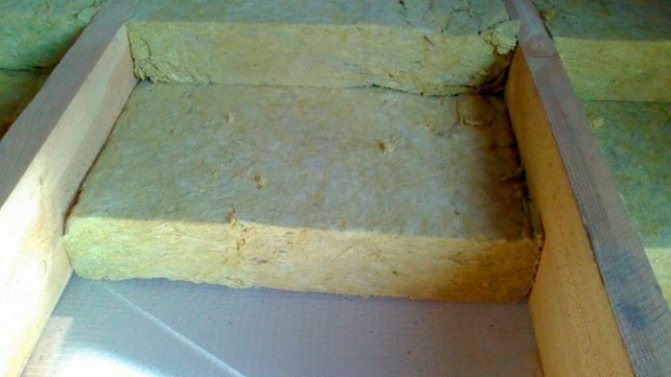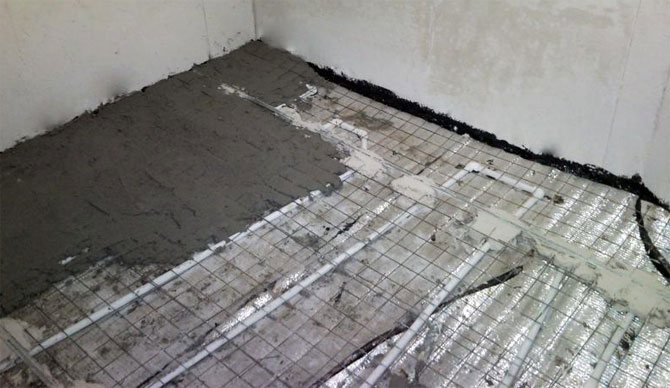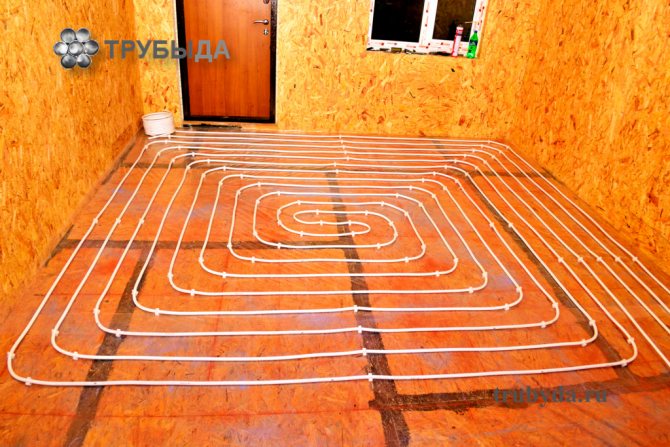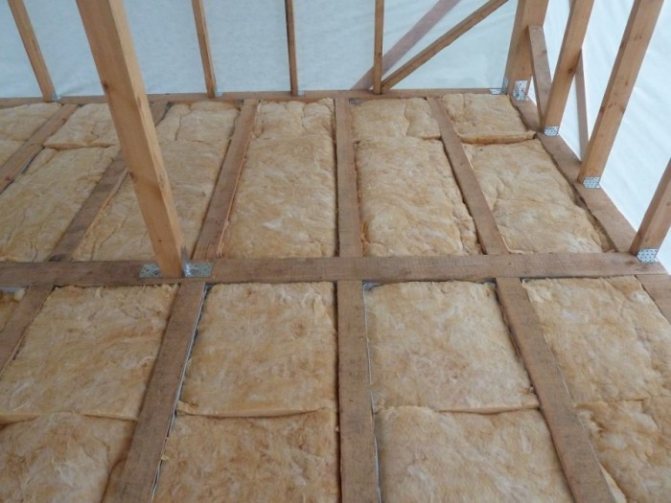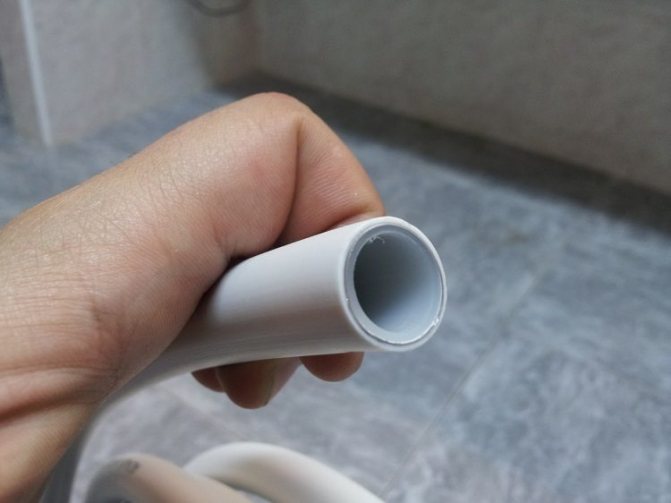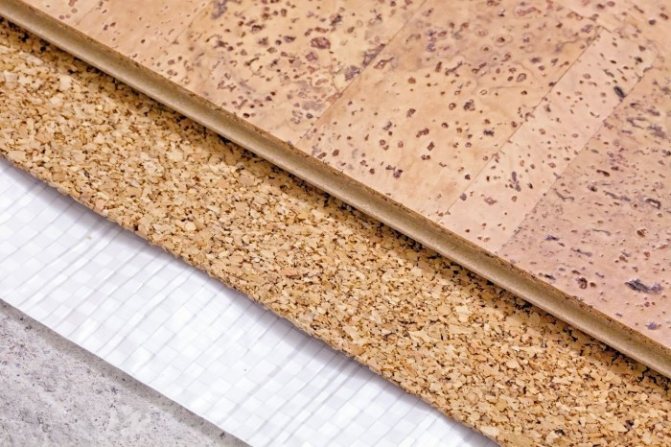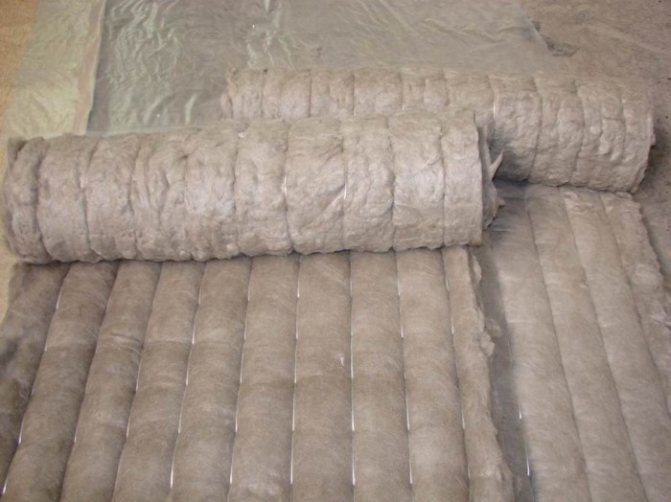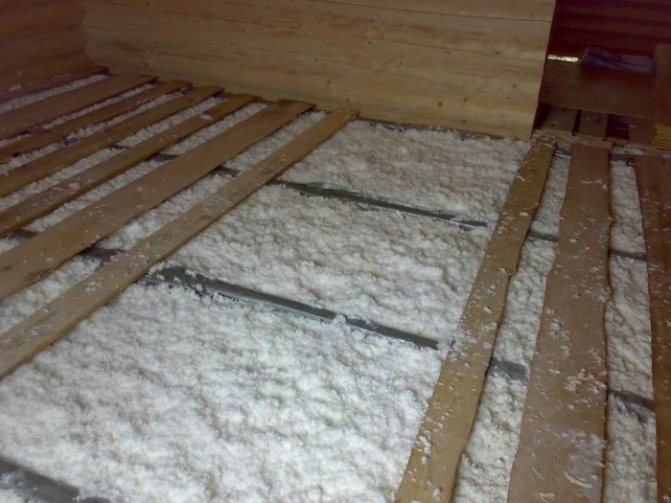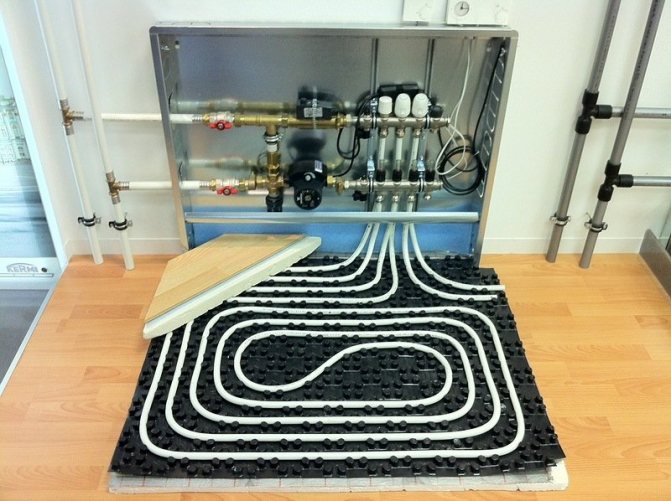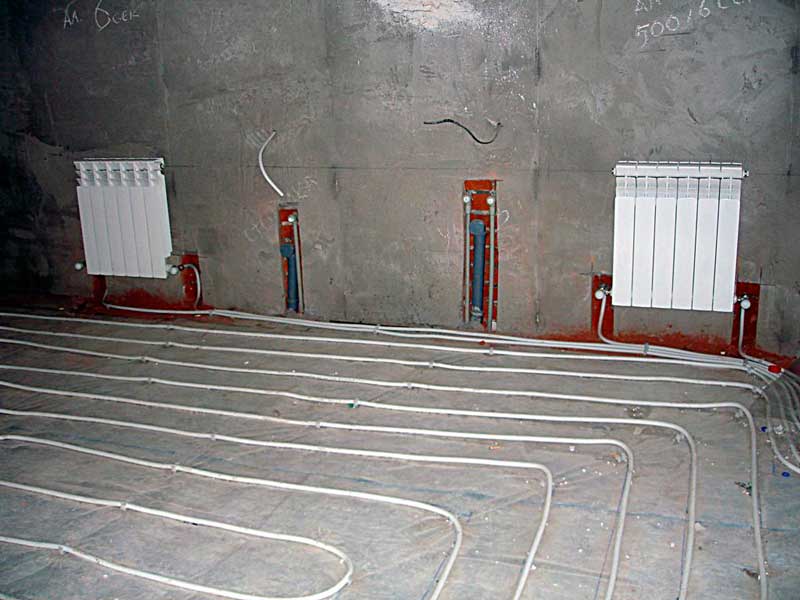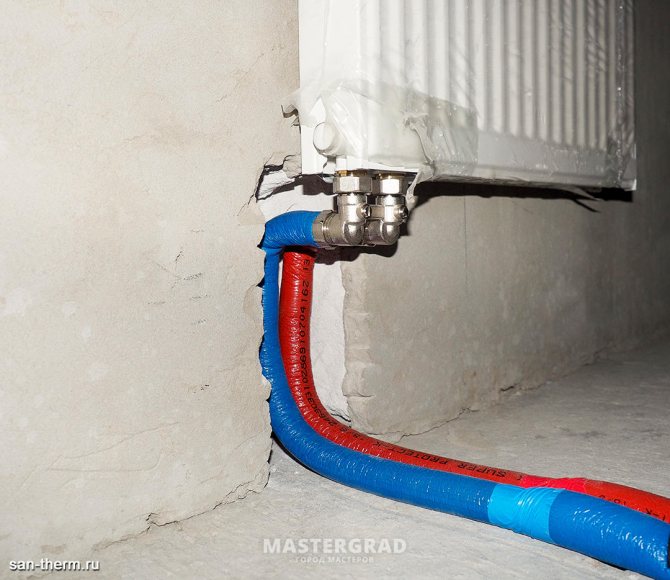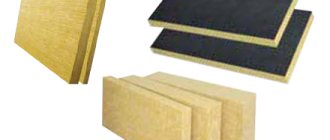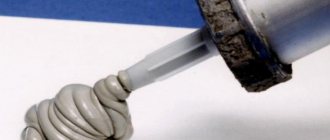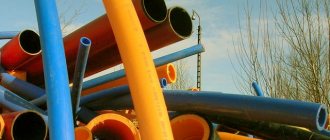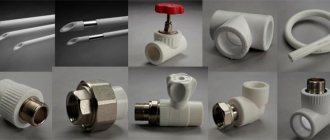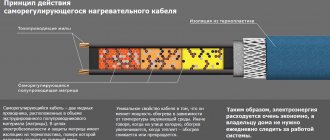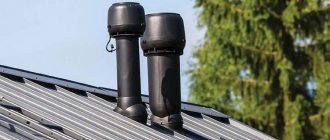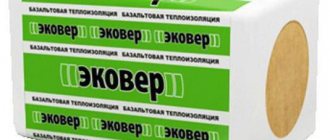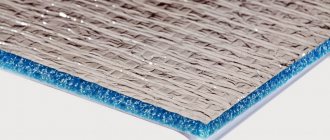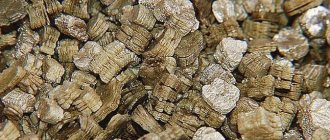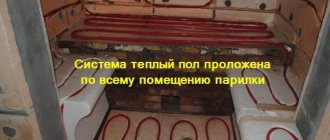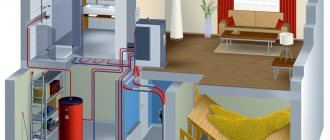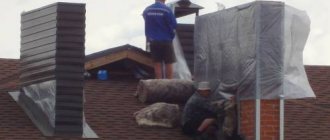Types and technical characteristics of foil insulation
On the construction market, foil insulation is presented in several types:
- Foamed polyethylene foam: roll-up self-adhesive material. It is mainly used for the device of a heat-insulating layer in technological equipment, pipes and air ducts
- Foil mineral wool: Available in slabs, cylinders and rolls. Due to its high degree of fire resistance, the material is widely used for insulating chimneys, roofs, walls of saunas and baths
- Foil polystyrene foam (with double-sided foil): resistant to temperature fluctuations in the range (-170 - +170 degrees Celsius). Most often it is used when installing a heat-insulating layer in warm floors. Foil polystyrene can be used to insulate the space under the roof
- Foil-clad basalt thermal insulator: the most resistant to aggressive environments among all foil-clad heaters. Does not change its properties under the influence of temperature differences from -190 to +600 degrees Celsius. Mainly used in the heat and power industry, aircraft construction, in the construction of gas stations
Despite the difference in the composition of foil-clad insulation, they are united by a number of technical characteristics:
- Resistant to temperature fluctuations
- Moisture repellent properties
- High vapor permeability (0.001 mg / m.h.Pa)
- High indicators of the efficiency of reflection of thermal radiation (the average thermal conductivity is 0.037 W / m ° C)
- High sound insulation properties (sound absorption - up to 68%)
Foil reliably protects all types of insulation from solar and radon radiation. In addition, thermal insulation materials of this kind do not require additional treatment with chemical agents, which has a very positive effect on the level of their environmental friendliness.
Manufacturers position foil insulation as a durable material that can last up to 95 years. However, it is very problematic to verify this statement.
A wide variety of materials can be found from thermal insulator suppliers. Any buyer immediately asks the question "How to insulate the house from the outside?" Perhaps one of the most popular materials is rock wool, as it has excellent resistance to high temperatures.
Minvatoi also insulate the roof. We advise you to familiarize yourself with the types and installation of mansard roof insulation in this article. The roof must be insulated.
Preparation of materials
Floor insulation begins with the acquisition of materials. You will need the following:
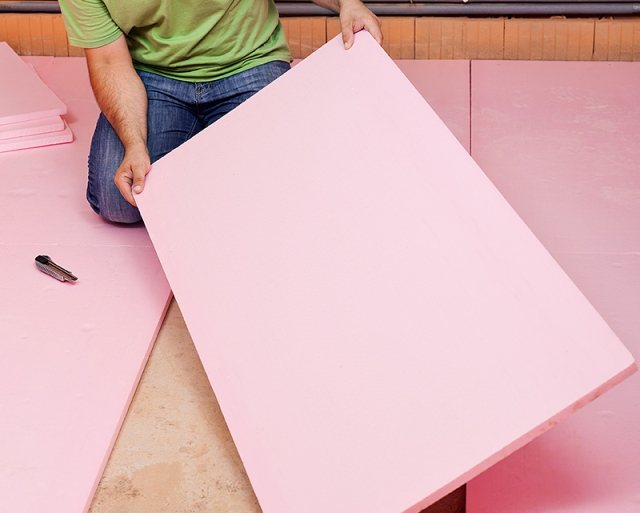
- extruded polypropylene plates;
- OSB boards;
- self-leveling floors for starting treatment;
- finishing self-leveling floors;
- waterproofing primer;
- polyethylene film;
- hammer-in dowels;
- liquid nails for fixing expanded polystyrene plates;
- liquid nails designed for wooden floors;
- plastic wedges.
Extruded polypropylene is a very lightweight material. It also contains additives that make it non-flammable, has minimal thermal conductivity and lasts a long time.
Polypropylene slabs can be cut with a regular knife.
Price and quality
Foil insulation is more expensive than usual, so the price is one of the main selection criteria. But you should not get too carried away with the economy, forgetting about the quality of the material.
On the market you can find fabulously cheap foil insulation under the wallpaper. Before you buy it, think about how the manufacturer was able to release such a cheap product? And the answer is very simple: instead of real foil, he applied aluminum spraying to the insulation.The material shines just like the real one, but the quality, alas, leaves much to be desired. The point is that the sprayed layer is too thin to trap thermal radiation. So, most likely you will pay more than for ordinary insulation, but you will not win in quality. As a result - an unjustified overpayment.
The average cost of high-quality foil insulation is:
- 60 - 80 rubles / sq. m - with a thickness of 3 mm
- 120 - 140 rubles / sq. m - with a thickness of 10 mm
Here are examples of prices for the most popular types of insulation:
- The price of Penofol insulation (foil on one side) 3 mm thick - a roll of 36 sq. m costs 1600 rubles
- A roll of Penofol with the same area, but 5 mm thickness will cost 1900 rubles
- Foil insulation Izodom 15 mm thick costs 100 rubles / sq. m
- The price of foil self-adhesive Penofol 2000 with a thickness of 5 mm - the cost of a roll is about 2300 rubles. The roll width is 600 mm, the number of meters in it is 30
We insulate the bath
To maintain heat in baths and saunas, and especially in steam rooms, reliable thermal insulation of the walls is required. It is quite difficult to do this, since these establishments are characterized by high humidity. Unprotected insulation is quickly saturated with moisture and loses its heat-insulating properties. This problem is solved by using foil for baths: you just need to cover the walls and ceilings of the room with it. Moreover, this foil can be used without insulation: the polished surface of the foil reflects the heat recovery back into the room (thermos effect).
Sauna foil is sold in rolls of 10 meters. The thickness of the material is 40 microns. The price of foil insulation for a bath is about 40 rubles / sq. m.
Video about foil insulation
Comparison of foil-clad insulation Penofol and its analogs.
The final stage
After installing the water circuit, you need to connect it to the collector group. One end is connected to the supply, the other to the return. After connecting to the manifold, it is necessary to test the heating system. This can be done by running the coolant into a warm floor. The system pressure should be higher than the operating pressure, but not more than 6 bar.
Every half hour you need to raise its level to the previous level. These actions are repeated three times, after which the floor heating is left alone for 24 hours. If during this time the pressure has dropped by no more than 2 bar, then the installation was successful. At the last stage, they go to the screed. When it is dry, you can start laying the flooring.
Types and technical characteristics of foil insulation
1) Insulation consisting of foamed polyethylene (polyethylene foam). The thickness of such insulation can be from 2 to 10 mm. One side of it is covered with a layer of aluminum foil. Most often, such insulation is supplied in rolls, has a low rate of thermal conductivity and water absorption.
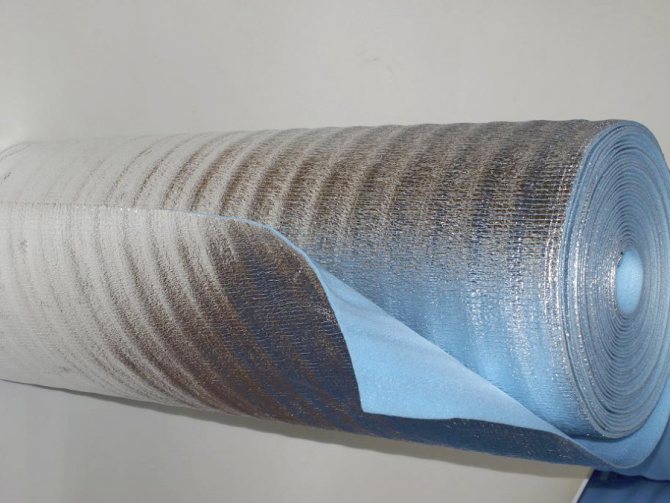

They are used for floor insulation, usually as the last layer in front of laminate, linoleum, parquet. Another application of this insulation is thermal insulation of water pipes and sewers, saunas and steam baths. In order to save heat once again, it is worth installing foamed foil insulation between the wall and the battery, not forgetting to leave a gap of 15-20 mm. It is not uncommon to see shoe insoles made of polyethylene foam to keep the shoes warm even at the lowest temperatures. Moreover, this type of insulation perfectly insulates sound. It is for this reason that sewer pipes in houses are covered with it, in order to reduce noise, thereby creating a comfortable environment for residents.
Let's start with reinforced plastic pipes
Pipelines made of metal-polymer, in other words, metal-plastic, pipes are recommended by Russian SNiP 2.04.01-85 and regulatory documents for use in hot and cold water supply systems and heating systems (SGV and SHV).
Reinforced-plastic pipes have advantages over other pipes:
- Working pressure - not less than 10 atm.
- Long-term temperature load - 95 С
- Service life at a temperature of 95 C - 25 years
- Service life at a temperature of 20 C - 50 years
- Oxygen diffusion, g / m3 day
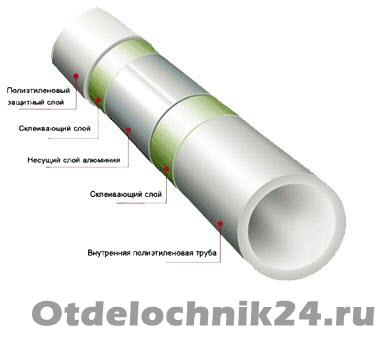

Reinforced-plastic (metal-polymer) pipes are a multilayer structure consisting of a thin aluminum pipe (0.5 - 2 mm thick) coated on the outside and inside with cross-linked polyethylene (PE-X). Polyethylene is fixed on an aluminum backing with glue.
1.
"Layered" construction of a metal-plastic pipe makes it more reliable and durable (50 years or more). Each layer of the structure has its own purpose:
- the aluminum core guarantees protection against oxygen diffusion through the pipe wall;
- provides a small TCLE - 0.024 ... 0.026 mm / mK;
- guarantees long-term strength at elevated temperatures.
2. XLPE layers:
- ensure the smoothness of the inner surface of the metal-plastic pipe and protect it from fouling;
- protect the aluminum core from the formation of galvanic pairs with brass and steel network elements;
- reduce the thermal conductivity of the pipe;
- protect it from fogging; provide decorativeness and cleanliness of the outer surface of the metal-plastic pipe.
Reinforced-plastic pipes are produced with an outer diameter of 16 to 63 mm. Pipes are supplied in the form of coils with a length of 200 to 50 m.
Polymer-metal pipes are easy to use: they are flexible, easy to cut and join using a set of special tools, fittings and fittings. The weight of metal-polymer pipes, depending on the diameter, ranges from 0.1 to 0.3 kg / r.m.
MP pipes are new generation pipes that combine the advantages of metal and plastic pipes. The inner and outer plastic layers have a very low roughness and prevent corrosion. Thus, there is no rust or corrosion in the plumbing. Working fluid temperature: from - 40 to + 95 ° С.
Price and quality
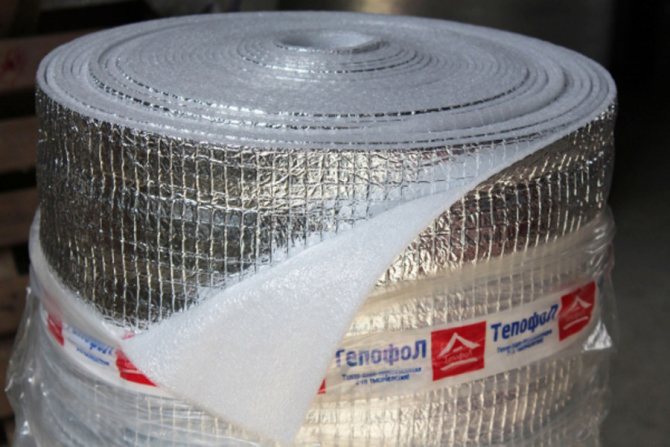

Foil insulation Tepofol, type "A"
The cost of foil insulation varies from 60 to 85 rubles / sq. m for a 3 mm layer and from 120 to 145 rubles / sq. m per layer of 10 mm. For example, let's take the prices of a well-known insulation - penofol (only one side is covered with foil). 36 sq. m of this insulation with a thickness of 3 mm will cost 2,160 rubles. Absolutely the same, but with a thickness of 5 mm - 2500 rubles.
Self-adhesive Penofol will be more expensive - 2900 rubles per roll of 5 mm thickness. The roll has a length of 30 m and a width of 0.6 m, which is quite convenient for installation.
Of course, foil insulation is an expensive option for thermal insulation, but do not forget about such factors as quality, durability and reliability. This can be neglected and spend your money by buying wallpaper insulation. But the fact is that in fact it is not foil. Instead of foil, aluminum spraying is used in wallpaper insulation. The appearance will not always give it away - it also shines brightly and beautifully, but it is not able to reflect heat. Therefore, before such a purchase, think about: is this savings worth it?
Floor heating: advantages and disadvantages
Before hiding the heating pipes in a concrete screed, it is necessary to study in detail all the pros and cons that this heating system demonstrates. They should not be ignored, because this will guarantee that finances will be invested wisely.
Consider the benefits of a floor heating system.
- Long period of use.
- Uniform level of warm-up.
- The system in concrete flooring is distinguished by cheaper maintenance when compared with the classic options.
- Easy maintenance.
- No moisture.
- Economical use of space.
- Complete safety (installation of the system in a concrete screed avoids childhood injuries and burns from hot pipes).
- The required humidity rate is constantly maintained in the air.
There are not many disadvantages of the network under the screed, but you need to familiarize yourself with them.
- First of all, when laying the heating line under the screed, the height of the room is reduced.
- Repairing pipes is not as easy to carry out as in classic cases, because it is not easy to find a leak in a hidden line.
- Installation in specific places will not work. These include a flight of stairs, etc.
IMPORTANT! These buildings in mansions are carried out without restrictions, and the apartment will require a different approach. In apartment buildings, you need to make sure that the central network can handle the high hydraulic load.
The disadvantages must be carefully studied, and you need to be prepared for the fact that sooner or later the heating in the screed may leak. Do not forget that it is not easy to detect a leak on a pipe in such structures.
And after determining the location of the leak, repairs will not be easy. Therefore, it is important to approach work with full responsibility.
Installation of foil insulation
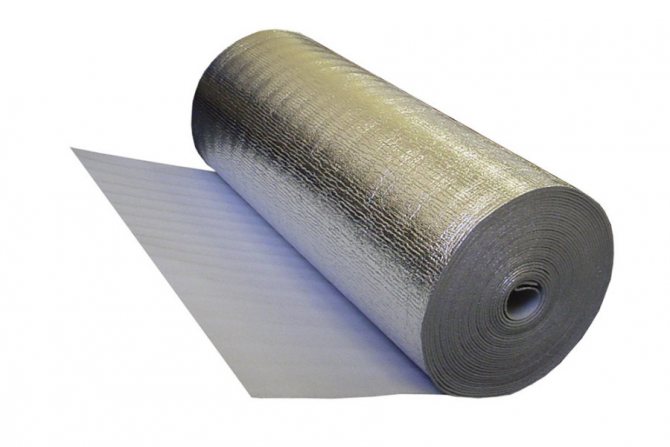

- During installation, it is important to strengthen the foil insulation with foil inside, because it is this side that will reflect heat, thereby preserving it.
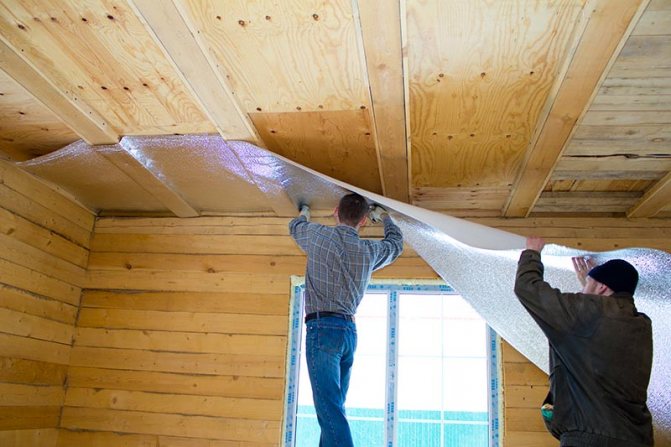

Shiny side inward to reflect heat
- Lay close to each other to avoid heat loss. Fastening will be carried out by means of a usually construction stapler. If you are going to insulate the walls, the material should be placed between the crate guides.
- The joints of polyethylene foam will help to close the special metallized tape.
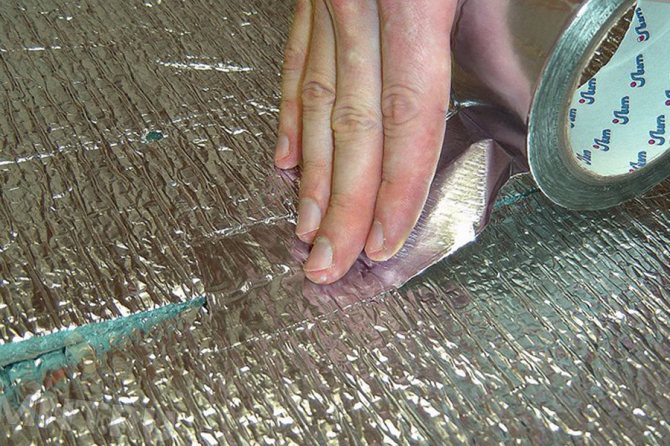

Bonding joints with special tape
- It is necessary to leave an opening of 20-25 mm between the foil insulation and the final finish.
Laying OSB tiles
After laying the foam boards, you can begin to install the topcoat. OSB boards are made from compressed chips - due to the press, the sheets acquire special strength and withstand heavy loads.
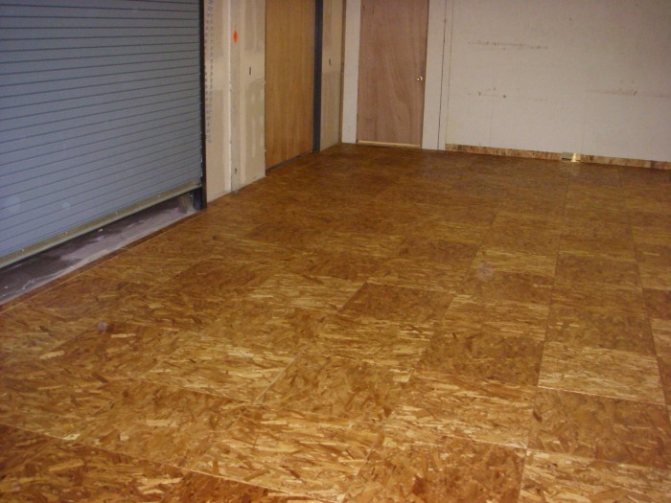

When installing wooden boards, it is important to ensure that there is a free gap of at least 5 mm at each wall. To maintain this distance, wedges are needed near the walls. In the future, floor insulation is carried out in the following sequence:
- wedges are placed against the walls;
- OSB boards are stacked close;
- plates are attached and wedges are removed;
- all traces of dowels must be covered with liquid nails.
We insulate the bath
Baths and saunas are places where you especially need to keep warm. The whole difficulty in insulating these premises is that they have high humidity. Ordinary insulation will very quickly absorb moisture and cease to retain heat, which is pretty bad. But this problem can be solved. There is a special foil for baths, which is used to cover the walls and ceilings. Moreover, the foil can be used without the insulation itself, because the heat will be reflected by its surface. This is called the thermos effect.
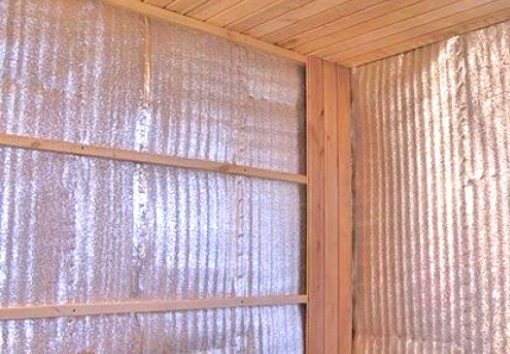

You need to think about insulating your home even at the stage of its construction, because this will help you save most of your energy resources. But what your insulation will be, you must decide for yourself. Also, it will not be superfluous to consult with specialists who can analyze the place of insulation and choose a decent insulation for you.
What types of materials can and cannot be used
Before making a screed, you need to find out which heating pipes from which materials will be most suitable for installation in the floor. There are many options - you can choose products made of copper, you can stay on such an inexpensive and practical material as plastic, which, in the case of competent installation, will work "one hundred percent".
It is also worth paying attention to metal-plastic products. Which one is better to choose from? In order to answer the question posed, we will consider pipes from the listed materials in more detail.
Pipe products for laying in the floor must have the following properties.
- High strength index.
- Resistant to corrosive formations.
- Impermeable to oxygen, which causes corrosion of the steel parts of the heating network.
- Good heat dissipation.
- Small coefficient of expansion.
- Environmental friendliness.
The listed requirements for laying in a floor under a screed are fully met by an assortment of the following materials - polyethylene, polypropylene and metal-plastic.
Polyethylene pipes
and other types of pipes that are used in a screed have pluses and minuses, therefore, before you hide them and make a screed, you need to study each material thoroughly.
Polypropylene pipes
for laying in a screed compares favorably with low cost. However, these products are not widely used. The reason is that polypropylene pipes hidden in a screed have a number of significant disadvantages.
So, the polypropylene (PP) assortment is distinguished by an eight-diameter bend radius. When laying a polypropylene underfloor heating system, this affects the distance between adjacent branches of the line.
If the diameter of the polypropylene line is 15 mm, then the branches are separated from each other by 120 cm, which will have a bad effect on the heating of the room. It is also possible to mount a polypropylene water-heated floor only at a temperature of at least fifteen degrees. Polypropylene products are inexpensive and have a large number of positive characteristics.
Polyethylene pipe-rolling materials
only crosslinked ones are suitable for this task. Cross-linked polypropylene is durable, reliable and resistant to high temperatures. But, in a cement floor, these pipes do not hold their shape well. Therefore, a large number of fasteners must be used to fix such pipes.
Experts speak well of metal-plastic products. The metal-plastic pipe used in the screed lasts quite a long time.
Metal-plastic products appeared on the market not so long ago, but quickly took the leading position. The special three-layer construction of these pipe-rolling materials allows them to serve up to 30 years.
The disadvantages that metal-plastic pipelines have include the relative complexity of installation work at home. not difficult if you have some experience of such work.
Therefore, it is important to know the sense of proportion when clamping. At home, laser or ultrasonic welding is not used for this product range.
If it is bad to clamp the joint, then you should wait for leaks. And, if you "pinch", then the fitting will fail, and it will have to be replaced.
But the pipe rolling copper
enlisted in a number of impeccable leaders. It is far superior to polyethylene counterparts. Cross-linked polypropylene and metal-plastic are also inferior to copper. In this case, there is only a huge list of positive characteristics.
Watch the video
And copper products have one drawback. That's too much high price
, which becomes the reason that not everyone can afford to use a structure made of this material for laying under a screed.
Speaking about the "warm floor" system, you need to remember such a material as metal. Metal pipe products
in a screed, experts call an unreasonably risky undertaking. Heating water is often saturated
chemicals
and metal can just
not resist
before this aggressive influence.
Ultimately, corrosion appears in the metal structure, which means further leakage. Hard water also has a detrimental effect on metal.
Therefore, plastic and copper products are a more practical solution for floor installation. Therefore, metal pipe-rolling materials are not recommended for this work.
Premises preparation
Before sealing the heating pipes in the floor screed, it is necessary to bring out all the connection points of the remaining communications, and put windows and doors.It is recommended to take out pieces of furniture from the room, and dismantle the old heating system, if this work is not carried out in new buildings.
Irregularities on the surface are allowed within a radius of one centimeter. If their dimensions exceed these figures, then the base for heating should be leveled.
The final stage of the preparatory work is cleaning. Before sealing the structure with a concrete screed, it must be done without fail. Industrial vacuum cleaners are perfect for this task.
Laying "warm floor" in the screed
This option is used in an apartment and in a private house. It is even used for wood flooring or under surfaces such as laminate.
Pouring is performed on a rough or wooden floor. They act in these situations according to the same principle.
- Spread the waterproofing.
- Insulation is laid.
- Reinforced mesh is laid.
- Wiring and fastening of the pipeline is in progress.
- Glue the damper tape.
- The entire structure on the floor is filled with mortar.
We carry out waterproofing
It protects against moisture ingress and to prevent wet mortar from coming into contact with the floor. After that, it is necessary to insulate the work surface. The best option for this task is foam. Also, high marks from specialists received a material derived from polystyrene - penoflex.
A steel mesh is applied to the insulating material. It is needed to evenly distribute the load over the frozen fill. Without such reinforcement, the screed can crack.
Piping in such networks is performed in two ways.
- A snail.
- Snake.
The first scheme is the laying in a circle from the walls to the center of the room. Such actions do not use sharp turns of the circulation direction.
The snake is directed from any wall, and then directed to the other, located on the opposite side. With this design, on all pieces, the direction of movement of the liquid is changed by 180 degrees. In everyday life, the first styling option is most often used.
The contour should be reinforced on the surface. With these actions, it should be borne in mind that it increases the dimensions in length. Therefore, the fasteners cannot differ in rigidity, and the pipeline must be able to slide. For such a task, plastic clips attached to the floor are effectively used. You can also use simple clamps.
It is very important not to forget to use a damper tape. It is a strip of expanded polymer material. It needs to be glued around the perimeter of the room on the wall. And the bottom edge of the tape should run across the floor. This measure will help neutralize the increase in pouring, and will not allow the solution to stick to the walls.
Many are interested in how many centimeters the screed must cover the pipe structure. Masters say that it cannot be less than three centimeters. Its optimal size is 7 cm.
Watch the video
When laying heating pipes, it is very important to maintain the same pitch between turns or zigzags. So, for example, for a room of 20 sq. m, this distance is twenty centimeters. In a room with a large area, it is recommended to install several spirals or snakes for heating.
Floor heating pipes can be hidden under wet or dry fill. The first method is more common. Because with "dry" filling with voids, a lower density level is obtained, and because of this, heat transfer is inhibited.
It is not difficult to build such a heating structure with your own hands. The main thing is to have patience and some knowledge. If you add a little more effort to this, then the excellent result of the heating in the floor can please more than one decade.
(2
estimates, average:
5,00
out of 5)
The discussion is closed.
Often, hearing the word "heating", people remember the heavy, rough, cast-iron batteries that were present in everyone's home during the era of the Union.The radiators took a long time to warm up, did not keep the heat in the apartment, and managed their function somehow. Now everything is different - there is an opportunity to choose among worthy alternatives. The most advanced of them is the "warm floor" system. Therefore, we are learning to install heating pipes in the floor screed.
The warmth starts from the feet
Polypropylene (PP) - physical properties and characteristics
PP is a plastic polymer with resistance to aggressive chemicals, flexibility and low vapor permeability.
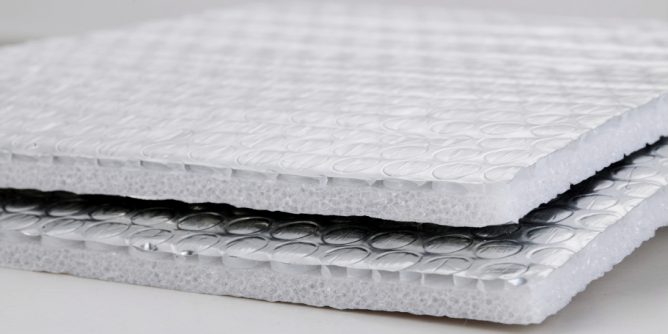

Polypropylene products are made in 5 main ways:
- injection molding;
- extrusion;
- rotational molding;
- blowing out;
- foaming.
The material obtained by foaming polymer granules has found wide application in heat, steam and sound insulation of building structures and pipelines. To give it special properties, plasticizers, flame retardants, antistatic and other substances are added to PP granules. Porous or expanded polypropylene (PPP) is molded in the extrusion process.
Screed pipes
All of these characteristics are possessed by plastic pipes. When making a choice in favor of these pipes when laying heating pipes in the floor screed, it is necessary to choose reinforced products.
Each type of underfloor heating pipe has pros and cons. Let's consider their differences from each other.
Polypropylene pipes
The undoubted advantage of these pipes is their low price. But for the device of warm floors, polypropylene pipes are used very rarely. This is due to a number of disadvantages.
The bending radius of polypropylene pipes is up to 8 diameters. Adjacent turns of the pipeline with a diameter of 15 mm will need to be located at a distance of 1.2 meters from each other. In this case, there is no need to talk about any efficiency of the heating system. And the use of additional fittings will lead to an increase in the cost of the entire system and an increase in the chances of pipe leakage at the joints.
Properties of insulating materials based on PPP
Expanded polypropylene has the lowest thermal conductivity in its class. The gas-filled polymer has a density of 40 kg / m3, its closed pores provide moisture resistance and high strength. The elastic material does not deform during operation. It belongs to products with low flammability, does not emit dangerous toxic gases during combustion.
Synthetic insulation is environmentally friendly and safe for health; contact of polypropylene with food is allowed.
The cellular structure helps to absorb sound and vibration; the use of PPP is recommended for soundproofing buildings. To enhance the properties of the insulation, it is laminated with foil or lavsan threads. Composite products can be coated with non-expanded polypropylene. The most famous material with EPP lavsan and foil coating. It is produced in the form of rolls of 15, 25 m thickness of the web from 2 to 10 mm. The size of the sheets is 1 × 1, 2 × 2 m, the thickness is up to 20 mm. The insulation is easy to cut and easy to install.
Range of expanded polypropylene sheets
In the building materials market, in addition to expanded polypropylene sheet, you can often find modifications created on its basis. One of the most popular composites of this type is EPP, which consists of expanded polypropylene sheet covered with Mylar fiber or foil. In some cases, the role of the coating is assigned to conventional polypropylene.
The dimensions of EPP sheets differ for each manufacturer. So, in most cases, the material is supplied in rolls with a width of 1.2 m and sheet thickness from 2 to 10 mm. In this case, the length of the roll is from 15 to 25 meters. Polypropylene in foamed sheets can be up to 20 mm in thickness. In this case, the dimensions of the sheet are mainly standard: 1 * 1 m, 2 * 2 m, 1.5 * 3 m, 1.5 * 4 m.
Applications of PP-based insulation
The main characteristics of the material: low thermal conductivity, sound absorption, resistance to moisture and decay, have determined the area of its use.
Insulation materials made of polypropylene are used to insulate roofs, walls, floors, loggias and balconies, as well as pipelines and heating mains.
They do not require the installation of additional hydro and vapor barrier. EPP is used for the manufacture of thermal containers used in everyday life and for the transportation of medical products that are sensitive to temperature changes.
Foamed polypropylene foam is widely used in rooms with high humidity and sudden temperature changes. One of the popular brands is "Penotherm", developed for the insulation of baths and saunas. The reflective layer of insulation prevents the release of infrared waves and reduces the heating time of the steam room by 3 times. Its thermal insulation characteristics and moisture resistance are higher than those of similar materials based on polyethylene.
Porous insulation is used to create a sound-insulating layer of partitions and interior walls. Lavsan-coated material is in demand as a substrate when installing a "warm floor" system.
Application of expanded polypropylene:
Due to the unique properties of expanded polypropylene, it is in demand in various fields of industry. The main options for its use are:
- Insulation of building facades from the outside.
- Insulation of sandwich panels and in-wall cassettes of enclosing structures of industrial buildings and structures.
- Sound absorption of internal partitions and walls in the room.
- Hydro and thermal insulation in those rooms where the level of humidity is high and sudden temperature changes are possible. These are, for example, saunas, steam rooms, bathrooms, baths.
- Vibration isolation during flooring and in the process of installing floor coverings using the "warm floor" technology.
- Soundproofing in the car.
- For filling filters in water treatment plants. Here, not pure expanded polypropylene is used, but its composites.
- Manufacturing of packaging containers for various purposes.
- Production of thermos containers for transportation of medical supplies and instruments. Advantageously, foamed foam is used in this case.
- Shock-absorbing cushioning in motorcycle and bicycle helmets.
Features of the use of polypropylene pipes
For the organization of underfloor heating, all the material used must meet certain criteria. This is because the pipe system is subject to high stress. The pipes will be under constant mechanical stress: poured concrete, installed furniture, people walking, etc.
Note! If you purchase a low-quality material, then this may end in a pipe breakthrough, which will entail the dismantling of the flooring and concrete screed. And this is a big financial cost.
As for polypropylene pipes, they fully comply with the requirements for similar products for underfloor heating. The following are the advantages of polypropylene pipes:
- Reliability and long service life - about 50 years.
- Bending ability. In places of bending, they do not lose their integrity and strength.
- When joining, sealed joints are formed.
- Affordable price.
- Oxygen molecules do not penetrate into the product.
- The pipes can withstand significant mechanical stress.
As for the disadvantages of a warm floor made of polypropylene, this is the mandatory use of specialized welding equipment. At the same time, it is important to have at least a little experience in welding polypropylene pipes. Otherwise, there is a risk of leakage at one of the joints.
Before laying pipes, it is important to carry out a number of mandatory preparatory work.Otherwise, you will not heat the air in the room, but the base lying under the pipes. Therefore, thermal insulation is carried out to efficiently distribute thermal energy. All preparatory work is performed in several steps:
- A layer of waterproofing is placed on the rough screed. For this, you can use a thick plastic film. If you live in your own home, the moisture present in the soil will not rise upward. The film should be wrapped 100 mm on the wall.
- The next stage is the laying of the thermal insulation material. In most cases, extruded polystyrene foam is used for this purpose. This material is highly resistant to mechanical stress. It is resistant to moisture, so extruded polystyrene foam is best suited for thermal insulation of concrete floors. The installation of the material is carried out in a checkerboard pattern. If the rough screed is uneven, then gaps can form at the joints of the plates, which can be filled with polyurethane foam. But prudence should be shown here. If the floor is too uneven, it can negatively affect the heating system. Additional hydraulic resistance will form in the pipes. It is also recommended to fill the gaps between the wall and the expanded polystyrene plates with foam.
- To increase the quality of insulation, penofol, which is a material made of polyethylene foam, can be laid on top. It has a layer of aluminum foil on one side. Due to the reflection, the thermal energy will rise up and, accordingly, warm the air in the room. Penofol joints are glued together with construction tape.
Note! Each preparatory step must be carried out accurately and in accordance with existing technology. In this case, you will be able to create warm underfloor heating.
The flow rate of the pipe will largely depend on the layout of the heating circuit, for example, in a zigzag or a snail. When using polypropylene pipes, the recommended laying pattern is “snail”. Although it is a little more complicated in installation, it is more effective when operating a warm floor. In any case, the scheme will have an irregular geometric shape with a large number of bends and turns with different radii. Given this, calculating the exact footage of the required pipe can be problematic. In this case, you can use two methods:
- by making a project on a sheet of paper on a millimeter scale;
- using a long thread.
Creating a project on paper will take more time. For this, the shape of the heated room is transferred onto paper. Draw the pipe layout. The resulting snake or zigzag is measured with a ruler and the length of the pipe is obtained. Another method requires the use of a sturdy rope. To do this, it is laid in the way that the pipe will lie. At the end, the rope just needs to be measured.
Note! It does not matter which method you use to measure the length of the pipe, you need to add 10% to the overrun to the figure obtained from above.
If you lay polypropylene pipes according to the "snail" scheme, then two pipes will run in parallel (supply and return). The use of such a scheme will simplify the procedure for bending polypropylene. The pipes are fastened using special metal clamps or plastic clips. The fasteners are fixed to the screed with dowels through the thermal insulation layer.
Note! Fastening a polypropylene pipe can be done in another way. For this, a metal mesh with large cells is laid. The pipe will be fixed to it. This mesh will serve as additional reinforcement for the screed.
When the pipe system is ready, it remains to connect the heating circuits to the manifold. At this stage, it is important to check the entire system for leaks. Therefore, under pressure, you run water into the warm water floor system and check each welding joint.
Note! The system must be equipped with an air release valve.
It is important to pay attention to some of the design features of the system. So, the step of the turns should be determined based on the task. If a warm water floor will serve as the main heating, the step should be no more than 150 mm. In the case of using the floor as an additional source of heat, the step is admissible up to 400 mm. In places where it is planned to install furniture or other large items, it makes no sense to lay a warm floor.
If, after checking the system, no malfunctions were found, then the screed can be poured. Then it is necessary to allow time for the filling to dry completely. In this case, you cannot turn on the heating. The concrete should dry on its own and as much as possible in natural conditions.
So, we discussed the basic rules of how to make warm floors using polypropylene pipes. We hope the above material will help you create a comfortable environment in a room with a warm floor. If you have your own experience in creating such a floor using polypropylene pipes, we will be interested in your opinion and personal experience. Leave your feedback at the end of this article.
Large linear expansion
If you are going to make heating with polypropylene pipes, then immediately lay down their use only in hidden installation. All pipes you will need to hide in the walls and screed, and preferably in insulation.
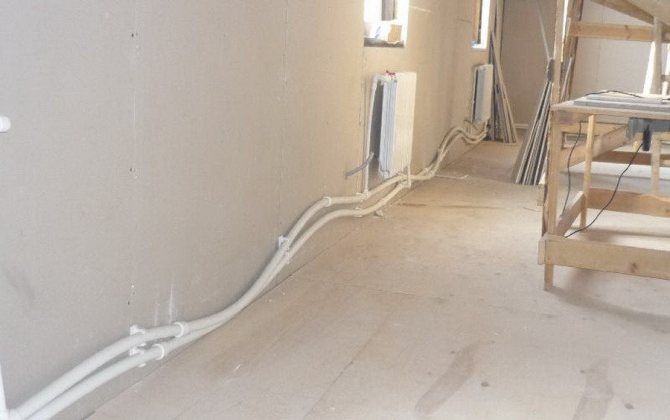

The main problem with polypropylene is its linear expansion. It is approximately 2.5 mm per one running meter. If you have installed straight pipes, then during operation they will surely "float" somewhere. Even if they are often fastened. If these pipes are located outside, then you are unlikely to appreciate such a picture.
It will be useful: How to independently repair a crack in a cast-iron sewer pipe

